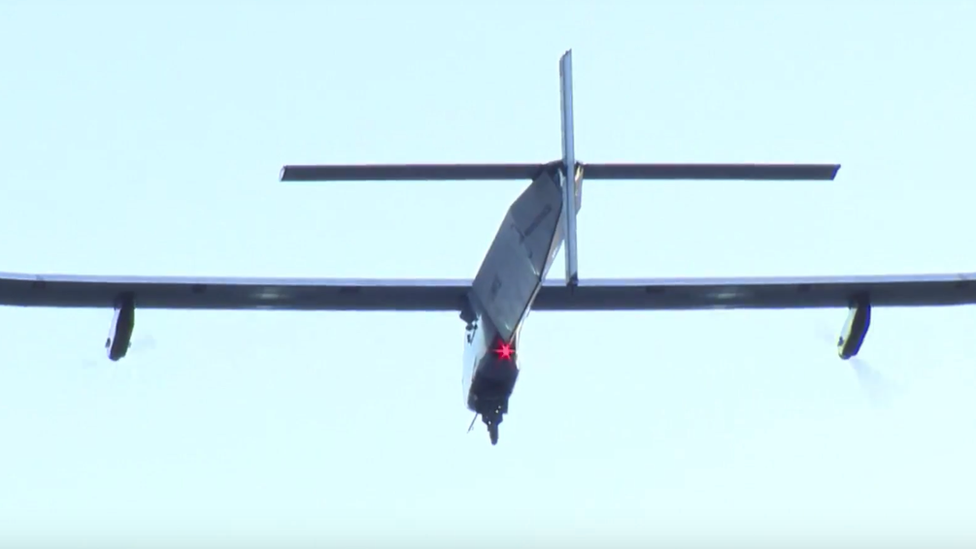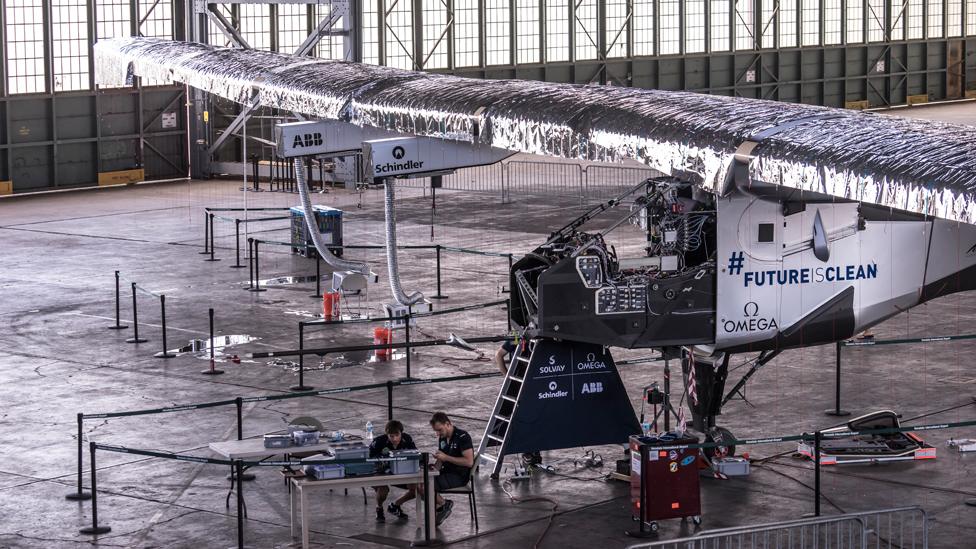Solar Impulse sets off for California after long lay-off
- Published

The plane should get to San Francisco on Saturday
The zero-fuel aeroplane, Solar Impulse, has renewed its effort to try to circumnavigate the globe.
The 72m-wingspan vehicle set off from Kalaeloa, Hawaii, at shortly after dawn local time, bound for San Francisco.
Swiss adventurer Bertrand Piccard is at the controls and expects the flight to take two-and-a-half days.
Solar Impulse, external gets all its energy from the sun - through the 17,000 photovoltaic cells that cover the top surfaces of the craft.
These power propellers during the day, but also charge batteries that the vehicle's motors can then call on during the night.
A high pressure zone has opened up, providing favourable winds that will take Piccard towards California and the famous Moffett Airfield.
His slow-moving, light-weight craft should arrive on Saturday evening.
Bertrand Piccard: "We've learnt that we can make a plane that can fly forever"
"The flight will last about 62 hours, but this is plus or minus three or four hours," said flight director Raymond Clerc, who oversees the mission with a group of engineers based in Monaco.
"The distance is 4,000km, 2,200 nautical miles, and we are very happy to have this window so early in the season."
Solar Impulse made aviation history with its exploits last year.
Starting in Abu Dhabi, UAE, in March, it crossed Oman, India, Myanmar, and China.
It then flew to Japan, before undertaking a 8,924km passage to Hawaii.
This five-day, five-night crossing set a record for the longest ever non-stop solo aeroplane journey.
But the vehicle's batteries overheated during the trip, forcing the project to lay over on the Pacific archipelago while repairs were conducted.
A further 20m euros (£16m; $23m) had to be raised from supporters during the winter to keep the project going for another year.
Bertrand Piccard said that was made easier by having a "proven product".
"We've learnt… that we can achieve the impossible. We can set goals that everyone considers are impossible, and with the dedication of a team, with creativity, with pioneering spirit - we can achieve it; despite all the specialists who are telling us that we could never do it."

The plane has been undergoing repairs in Hawaii
Piccard shares flying duties with his business partner, Andre Borschberg.
It was Borschberg who flew into Kalaeloa last July, and he will next take the controls once the plane has arrived in the US mainland.
The pair's intention is to get to New York by the start of June, to begin preparations for an Atlantic crossing.
Assuming this is completed successfully, it should then be a relatively straightforward run back to the "finish line" in Abu Dhabi.
Piccard and Borschberg have been working on the Solar Impulse project for more than a decade.
They first trialled a smaller plane, taking it on a trans-America crossing in 2013.
The version of the vehicle they currently fly is considerably bigger.
Its wingspan is wider than a 747 jumbo jet, and, yet, it weighs only 2.3 tonnes.
'Living creation'
Because the prop-driven craft moves so slowly, mission legs can take several days and nights of continuous flight.
This means Piccard and Borschberg - whoever is at the controls - have to stay alert for nearly all of the time they are airborne.
They are permitted only catnaps of up to 20 minutes - in the same way a single-handed, round-the-world yachtsman would catch small periods of sleep.
They also have to endure the physical discomfort of being confined in a cockpit that measures just 3.8 cubic metres in volume - not a lot bigger than a public telephone box.
But Borschberg says the experience so far has been exhilarating.
"An experimental plane is a living creation," he told BBC News.
"Each flight you do brings new learning that you can use to improve the quality, reliability and performance of the aeroplane."


LEG 1: 9 March. Abu Dhabi (UAE) to Muscat (Oman) - 772km; 13 Hours 1 Minute
LEG 2: 10 March. Muscat (Oman) to Ahmedabad (India) - 1,593km; 15 Hours 20 Minutes
LEG 3: 18 March. Ahmedabad (India) to Varanasi (India) - 1,170km; 13 Hours 15 Minutes
LEG 4: 18 March. Varanasi (India) to Mandalay (Myanmar) - 1,536km; 13 Hours 29 Minutes
LEG 5: 29 March. Mandalay (Myanmar) to Chongqing (China) - 1,636km; 20 Hours 29 Minutes
LEG 6: 21 April. Chongqing (China) to Nanjing (China) - 1,384km; 17 Hours 22 Minutes
LEG 7: 30 May. Nanjing (China) to Nagoya (Japan) - 2,942km; 1 Day 20 Hours 9 Minutes
LEG 8: 28 June. Nagoya (Japan) to Kalaeloa, Hawaii (USA) - 8,924km; 4 Days 21 Hours 52 Minutes


Jonathan.Amos-INTERNET@bbc.co.uk, external and follow me on Twitter: @BBCAmos, external
- Published16 April 2016